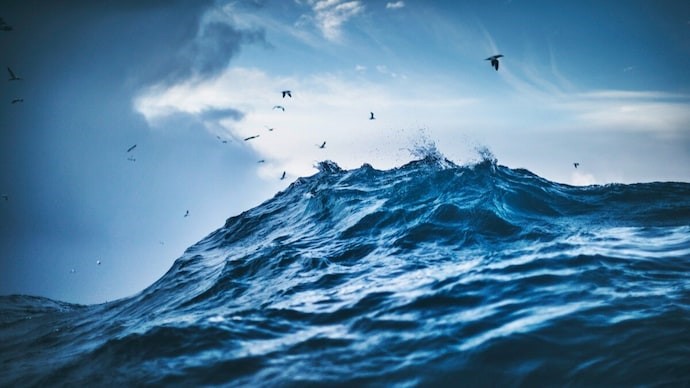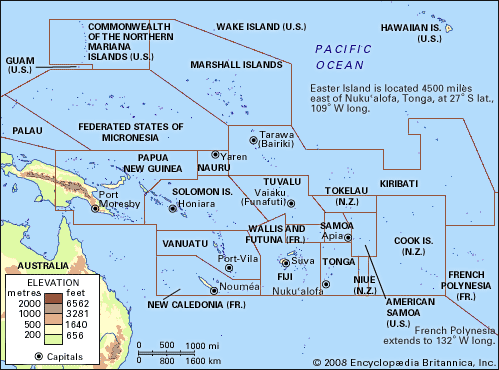Description

Disclaimer: Copyright infringement not intended.
Context
- The World Meteorological Organization (WMO) has issued a warning regarding the accelerating rise of sea levels around Pacific Islands.
- According to the "State of the Climate in the South-West Pacific 2022" report by WMO, sea levels in this region are increasing at a rate of approximately 4 mm per year, slightly exceeding the global average.
Details
Threat to Low-Lying Islands
- This rapid increase in sea levels poses a severe threat to low-lying islands in the Pacific, including Tuvalu and the Solomon Islands.
- These islands are at risk of experiencing destructive floods over time, leading to the potential destruction of agricultural lands and habitable areas.
Marine Heatwaves Impact
- The report also highlights the occurrence of marine heatwaves in a significant area northeast of Australia and south of Papua New Guinea, persisting for more than six months.
- These marine heatwaves have had a profound impact on marine life and the livelihoods of local communities, underscoring the vulnerability of the region's ecosystems.
Role of El Nino
- WMO Secretary-General Petteri Taalas emphasized the role of El Nino in contributing to the situation.
- El Nino, characterized by warming water surface temperatures in the eastern and central Pacific Ocean, is associated with disruptive weather patterns, higher temperatures, and increased occurrences of marine heatwaves and coral bleaching.

Natural Hazards and Losses
- The report reveals that the South-West Pacific region faced 35 natural hazards in the previous year, including floods and storms, resulting in the tragic loss of over 700 lives.
- These events directly affected more than 8 million individuals.
- Although the number of reported disaster weather events decreased compared to the previous year, economic losses due to flooding and weather events increased significantly.
Urgent Need for Climate Action
- The WMO report underscores the pressing need for comprehensive climate action.
- It calls for global efforts to mitigate the impacts of rising sea levels, extreme weather events, and other climate-related challenges.
- Immediate steps are required to safeguard the future of vulnerable island nations in the Pacific and mitigate the potential consequences of climate change.
Pacific Islands Overview
- The Pacific Islands encompass a vast expanse of the Pacific Ocean and consist of three main ethnogeographic divisions: Melanesia, Micronesia, and Polynesia.
- While these regions share commonalities, they also boast distinct cultural, linguistic, and geographical features.
- It's important to note that the term "Pacific Islands" conventionally excludes certain neighboring areas such as the continent of Australia, the Indonesian and Philippine archipelagoes, the Japanese archipelagoes, and other island arcs extending from Japan.
Geographical Divisions
Melanesia
- Melanesia, derived from the Greek words for "black" and "island," primarily refers to the islands inhabited by dark-skinned peoples.
- This region includes diverse islands such as New Guinea, the Bismarck Archipelago, Solomon Islands, Vanuatu, New Caledonia, and Fiji.
- The terrain here varies from lush tropical rainforests to rugged mountain landscapes.
Micronesia
- Micronesia comprises a collection of islands located north of the Equator and east of the Philippines.
- This region features a diverse range of islands, from the picturesque Palau with its pristine waters to the coral atolls of the Marshall Islands.
- It also includes the Federated States of Micronesia, Nauru, and Kiribati, each with its unique cultural and geographical attributes.
Polynesia
- Polynesia is characterized by its "poly" or many islands, located in the eastern Pacific.
- These islands form a triangle bordered by Hawaii to the north, New Zealand to the southwest, and Easter Island to the east.
- The islands here are widely scattered and include destinations like Samoa, Tonga, and the famous Hawaiian Islands.
- These islands are known for their beautiful landscapes, distinct cultures, and traditional practices.

Island Types and Formation
The Pacific Islands can be categorized into two major types based on their formation:
- Continental Islands: Located to the southwest of the Andesite Line, these islands tend to be larger and higher, with richer soil. Examples include the Marianas, New Guinea, Solomon Islands, and Fiji. These islands are often characterized by mountainous terrain and varied ecosystems.
- Oceanic Islands: Situated to the east of the Andesite Line, oceanic islands can be further classified into high volcanic-based islands and low coral islands and atolls. The volcanic islands, such as Hawaii, are formed from basaltic lava, while coral islands and atolls are the result of coral growth atop submerged volcanic or other cores. Atolls, in particular, develop when an island is submerged and the coral reef continues to grow, encircling a lagoon.
Population and Languages
- The Pacific Islands host a diverse population that includes Melanesians, Polynesians, Micronesians, and people of European origin.
- The largest concentration of the indigenous population lies in Papua New Guinea, while New Zealand has a significant population of European descent.
- The islands are home to hundreds of languages, many of which are of Austronesian origin. English or French is commonly spoken, often serving as official languages.
Economy and Trade
- The economies of Pacific Islands are typically developing, with major sectors being agriculture, fishing, services, and some mining.
- Exports from the region include copra (dried coconut meat), fish, minerals, cocoa, coffee, tea, and spices.
- However, imports generally exceed exports, leading to trade deficits.
- Tourism is a significant contributor to the economy, particularly in destinations like French Polynesia, Hawaii, Fiji, and New Zealand.
Conclusion
The warning issued by the WMO serves as a critical reminder of the urgency to address climate change. The report's findings highlight the immediate threat faced by Pacific Islands and emphasize the need for collaborative global action to prevent further environmental degradation and ensure the survival of these vulnerable regions.
MUST READ ARTICLES:
https://www.iasgyan.in/daily-current-affairs/wmo-state-of-global-climate-report-2022
|
PRACTICE QUESTION
Q. Which term refers to the island geographic region of the Pacific Ocean, comprising three ethnogeographic divisions—Melanesia, Micronesia, and Polynesia—but excludes neighboring regions like Australia and the Indonesian archipelago?
Options:
a) Oceania
b) Archipelagic region
c) Australasia
d) Insular region
Answer: d)
|

https://www.indiatoday.in/environment/story/pacific-islands-face-risk-of-drowning-as-sea-levels-rising-faster-than-expected-2422986-2023-08-18













